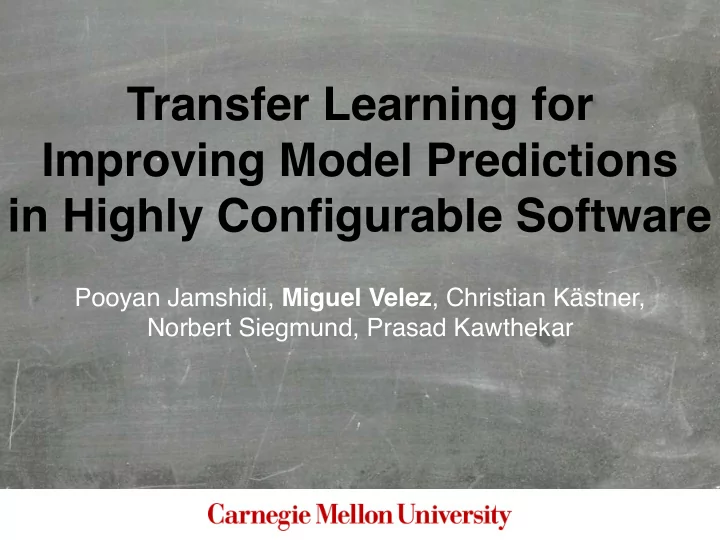

Transfer Learning for Improving Model Predictions in Highly Configurable Software Pooyan Jamshidi, Miguel Velez , Christian Kästner, Norbert Siegmund, Prasad Kawthekar
Highly Configurable Systems In Dynamic Environments [Credit to CMU CoBot]
Options Influence Performance
Adapt to Different Environments TurtleBot
Adapt to Different Environments TurtleBot 50 + 3*C1 + 15*C2 - 7*C2 *C3
Adapt to Different Environments TurtleBot 50 + 3*C1 + 15*C2 - 7*C2 *C3
Classic Sensitivity Analysis TurtleBot 50 + 3*C1 + 15*C2 - 7*C2 *C3
Classic Sensitivity Analysis TurtleBot Measure 50 + 3*C1 + 15*C2 - 7*C2 *C3
Classic Sensitivity Analysis TurtleBot Measure Learn 50 + 3*C1 + 15*C2 - 7*C2 *C3
Classic Sensitivity Analysis TurtleBot Measure Learn 50 + 3*C1 + 15*C2 - 7*C2 *C3
Applications TurtleBot Optimization Adaptation + Reasoning + Debugging + Measure Learn 50 + 3*C1 + 15*C2 - 7*C2 *C3
Measuring Performance is Expensive 25 options × 10 values = 10 25 configurations Measure [Credit to Peng Hou]
Transfer Learning
Reuse Data From Similar System TurtleBot Measure
Reuse Data From Similar System TurtleBot Measure Simulator (Gazebo)
Reuse Data From Similar System TurtleBot Measure Simulator (Gazebo) Measure
Reuse Data From Similar System TurtleBot Measure Reuse Simulator (Gazebo) Measure
Reuse Data From Similar System TurtleBot Measure Learn Reuse 50 + 3*C1 + 15*C2 - 7*C2 *C3 with TL Simulator (Gazebo) Measure
Reuse Data From Similar System TurtleBot Measure Learn Reuse 50 + 3*C1 + 15*C2 - 7*C2 *C3 with TL Simulator (Gazebo) Measure
Transfer Between Different Systems
Transfer Between Different Systems
Transfer Between Different Systems
Transfer Between Different Systems (0, 0) → (0, 10) (0, 0) → (7, 12)
Exploiting Similarity
Function Prediction Target function 200 Target samples 150 100 50 0 1 3 5 9 10 11 12 13 14
Prediction without Transfer Learning
Prediction with More Data but without Transfer Learning
Prediction with Transfer Learning
Technical Details
Prediction With Transfer Learning true function GP variance GP mean observation Motivations: 1. mean estimates + variance 2. all computation are linear algebra 3. good estimations with few data selected point true minimum
Prediction With Transfer Learning true function GP variance GP mean observation Motivations: 1. mean estimates + variance 2. all computation are linear algebra 3. good estimations when few data selected point true minimum https://github.com/pooyanjamshidi/transferlearning
Prediction With Transfer Learning true function GP variance GP mean observation Motivations: 1. mean estimates + variance 2. all computation are linear algebra 3. good estimations when few data selected point true minimum https://github.com/pooyanjamshidi/transferlearning pjsamshid@cs.cmu.edu
Evaluation
Case Study and Controlled Experiments RQ1: Improve prediction accuracy? RQ2: Tradeoffs among number of source and target samples? RQ3: Fast enough for self-adaptive systems?
Analyzed Systems Autonomous service robot Environmental change 3 stream processing apps Workload change NoSQL DBMS Workload & hardware changes
Prediction Accuracy
Performance Prediction for CoBot 25 25 20 Source 20 Model 15 15 10 10 5 5 0 5 10 15 20 25
Performance Prediction for CoBot 25 25 25 25 Source Target 20 20 20 20 Model Model 15 15 15 15 10 10 10 10 5 5 5 5 0 0 5 10 15 20 25 5 10 15 20 25
Performance Prediction for CoBot 25 25 25 25 Source Target 20 20 20 20 Model Model 15 15 15 15 10 10 10 10 5 5 5 5 0 0 5 10 15 20 25 5 10 15 20 25 25 CPU usage[%] 25 Prediction 20 20 with 4 samples 15 15 10 10 5 5 0 5 10 15 20 25
Performance Prediction for CoBot 25 25 25 25 Source Target 20 20 20 20 Model Model 15 15 15 15 10 10 10 10 5 5 5 5 0 0 5 10 15 20 25 5 10 15 20 25 25 25 CPU usage[%] CPU usage[%] 25 25 Prediction Prediction 20 20 20 20 with 4 samples with TL 15 15 15 15 10 10 10 10 5 5 5 5 0 0 5 10 15 20 25 5 10 15 20 25
Number of Source and Target Samples
Prediction Error with Different Source and Target Samples % Source %Target
Prediction Error with Different Source and Target Samples % Source %Target
Prediction Error with Different Source and Target Samples % Source %Target
Prediction Error with Different Source and Target Samples % Source %Target
Prediction Error with Different Source and Target Samples % Source %Target
Prediction Error with Different Source and Target Samples % Source %Target
Accuracy and Costs % Source B u d g e t %Target
Prediction error of other systems
Applicable in Self-Adaptive Systems
Transfer Learning in Self-Adaptive Systems Low model training overhead Produces accurate models Models can improve at each adaptation cycle
Future Work, Insights, and Ideas
Selecting from Multiple Sources C1 (1) Source Robot (4) Target Robot C2 (5) (2) C3 (3) Target Simulator Source Simulator
Active Learning with Transfer Learning TurtleBot Iteratively find best sample points that maximize knowledge Measure Learn Reuse 50 + 3*C1 + 15*C2 - 7*C2 *C3 with TL Simulator (Gazebo) Measure
Integrating Transfer Learning in MAPE-K Contribute to Knowledge Assist in self-optimization Support online learning
Summary
Transfer Learning for Improving Model Prediction in Highly Configurable Software Reuse data from similar system Improves model accuracy Applicable in self-adaptive systems
Transfer Learning Improves Sampling
Recommend
More recommend